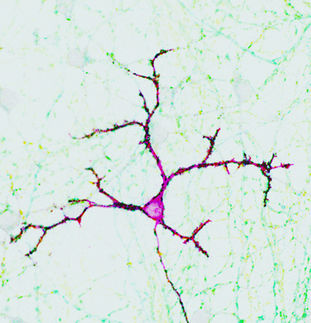Defective protein is a double hit for ataxia
Advertisement
The neurodegenerative disease spinocerebellar ataxia type 5 (SCA5) damages nerve cells in two ways. University of Minnesota researchers now report that the defective protein responsible for the disease cuts the number of synaptic terminals and snarls traffic inside neurons. The study appears in the Journal of Cell biology.
SCA5 results from a faulty gene for {beta}-III–spectrin. The disease targets the cerebellum's Purkinje cells, which control coordination. Symptoms usually start when patients are in their 20s or 30s, and they can gradually lose the ability to walk and speak. How the mutant protein damages Purkinje cells remains uncertain. {beta}-III–spectrin stabilizes synapses, suggesting that synapse deterioration might doom the cells. But the protein also helps the adapter protein dynactin hitch cargoes to dynein motors, pointing to a disruption of intracellular transportation.
Lorenzo et al. found support for both mechanisms. They engineered fruit flies to carry a mutated {beta}-III spectrin gene from either of two human families affected with SCA5, including one descended from Abraham Lincoln's paternal grandparents (whether Lincoln himself had the disease isn't clear). Fly larvae with the mutated gene had paralyzed tails. At the neuromuscular junctions where nerves and muscles meet, the larvae showed fewer presynaptic terminals.
The researchers next tracked the movement of synaptic vesicles in axons from the animals. Vesicles from flies that made the faulty {beta}-III–spectrin were slower and more likely to change direction, and thus traveled shorter distances. Other neurodegenerative diseases, including Alzheimer's disease and amyotrophic lateral sclerosis, involve faulty transport, and the results indicate that SCA5 does too.
The two mechanisms might have a common link, the researchers suggest. The complex containing {beta}-III–spectrin, dynactin, and dynein might not just haul cargoes. At the synapse it might snag microtubules that strengthen the membrane and prevent degeneration.
Original publication: Lorenzo, D.N., et al.; J. Cell Biol. 2010.























































